Text
Critical Analysis
Harrer, S. (2018) Games and bereavement: How video games represent attachment, loss, and grief. 1st ed. Germany: transcript. doi: 10.14361/9783839444153.
The author of this book is Sabine Harrer, PhD, currently a lead researcher on a Hertha Firnberg project studying racial equity in the European Games industry called White Play. She is also a senior lecturer at the Gotland Game Design Department of Uppsala University, with multiple honours and awards like Austrian Academy of Sciences (ÖAW) DOC fellowship and Bank Austria Innovative Teaching Award. She shows her strong passion for cultural studies and game design through her projects such as the epistemic games Overcoming, used to review 20th century grief literature and Jocoi, a game which explores pregnancy.
Based on her thorough research and considerable experience, Harrer published ‘Games and Bereavement : How Video Games Represent Attachment, Loss and Grief’ in 2018. The book is split into three parts: theory, in which the author explains the terminology and theory on which the research is based, analysis, in which the author discusses how loss is being represented in different games based on examples, and design, which talks about ways and tools that could be used to ethically represent grief. For my critical analysis I decided to analyse two of the pages subchapter ‘VIDEO GAME DESIGN AS EXPRESSIVE ART?’ which is located in the first part of the book Theory - Understanding Bereavement. I selected this fragment because the author explored video games as means for healing and accepting grief, just like other expressive arts such as music, painting and writing.
Harrer starts the first paragraph by expressing her opinion that the principles applied to the expressive arts can also be applied to game design as it combines many artistic areas, and uses the expressive modalities like visual arts, music and writing discussed by Neimeyer and Thompson, to sustain her argument. She ends the first paragraph explaining how through game, the expressive modalities can help the griever express and reflect on themselves. Moving forward, the author suggests that through the new layer of interactivity and ergodic continuum that games add to the experience of the receiver, people could develop their “idiosyncratic grief language”, which refers to the irrational fear of losing someone. Additionally, Harrer underlines that by having grief modelled through gameplay, the griever-designer becomes an active component and makes the experience more dynamic. Using a quote by Davies, the author emphasises the active exploration required by the designer in order to illustrate grief.
Following in the chapter, Harrer comes back to a previous fragment in the book where she explained Rossenblatt and Bowman’s hole metaphor regarding the connection of the bereaved and the deceased, but integrating it in the context of game design. She argues that through play the abstract emotional concepts of the metaphor can take form and become tangible, using tools of the game such as dynamics, mechanics and aesthetics. The first page of my analysis ends with the author stating that through this extension of the expressive arts in gaming, both the game developers and the players can benefit out of the therapeutic experience. Harrer supports her statement arguing that in the game design, both sides, the creator of the game and the one who experiences it, have to engage through multiple modal elements, creating a complex experience that can bring comfort to the griever according to their specific need.
In the second page I chose to analyse, the author continues using the hole metaphor to exemplify how having multiple expressive modalities in games, accommodates different priorities of the grievers. She also argues that due to their ergodic nature, games can create a wide range of sensory aspects, such as visual or audio, to support the griever and their needs. Harrer ends the paragraph by adding that even the stages of grief presented in the previous chapter, can be used as a guide for the player and integrated in the game system, even if the player does not know the stages or the “rules” of grieving.
Moving forward, the author talks about the mode through which the reception of emotions happens. Harrer further underlines that the player receives the emotion through play, emphasising the interactivity. She argues that unlike the other modalities, through play, the receiver is invited to explore a symbolic world, with personal contents and themes, and connect with the “emotional landscape” of the griever. Through the connection between the receiver (the player) and the griever (the character), the receiver symbolically takes a piece of the griever’s emotion.
The final paragraph from my selected pages discusses the compassion side of the process. Referencing Thompson, the author sustains the importance of a non-judgemental attitude when interacting with the bereaved. She explains that the game should be experienced and not analysed, for the connection between player and the grieving character to happen. Making a comparison with Stepakoff’s respectful echo, Harrer states that the player may have particular elements of the game with which they would resonate the most. The paragraph ends with a rhetorical question addressed by the author regarding the feelings that are evoked by the elements with which players emphasise. As a conclusion, Harrer underlines that interacting with the emotional triggers of the game not only honours the feelings of the griever, but also effort and tenacity of the game developers, who managed to illustrate a relatable experience.
Throughout the two pages I chose to analyse, Sabine Harrer built her arguments on a strong base of research and with multiple relevant references to high-quality external references. She brings a new and interesting perspective over a subject not being approached by many: the depiction of bereavement in video games. Starting with the idea of how video games can be used as expressive arts, the Harrer builds strong arguments regarding interactivity as a key element to connect with the griever through play, ways of using different modalities to evoke emotions in players, and the importance of an empathetic approach towards the griever when building the games systems.
To conclude, this is a high-quality source with logical arguments that provide relevant information on an important subject that is part of our lives. Harrer manages to approach a sensitive area that could be considered taboo by many in an objective and critical way, raising multiple questions. Her research may help game developers have a better understanding of strong emotions such as grief and how to depict them in a way that would honour the creators of the game, the bereaved and the players who receive the emotions.
0 notes
Text
10.Pushing Limits VR, AR, MR technologies - Even better than reality? analysis
In this blog post I will discuss the different paths virtual reality may take and the relation between how we perceive reality and how we perceive virtual reality. I will also present my opinion regarding the functionality of augmented reality, as well as the connection between the immersive experience and interactivity of VR (virtual reality).
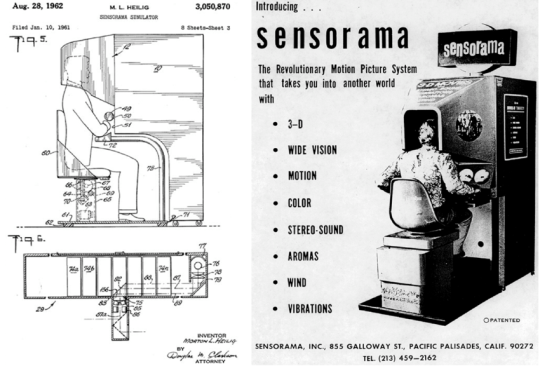
Fig.1 Sensorama
Since 1962 when Morton Heiling created Sensorama (fig.1), the first virtual reality machine, people have been trying to create and perfect this virtual world that would help people experiment with new sensations and worlds that otherwise, reality wouldn’t allow. The founder president of Center for Complexity Studies (U.N.E.S.C.O. centre and main promoter of Complexity theory in Romania), Florin Munteanu states on his website: “The past has become unfitting and the future hasn’t found its shape yet” (Florin Munteanu,2016). This further underlines my opinion that at one point, reality became insufficient or unattractive for some exploring minds, leading to the creation of a new digitised reality. In the 1980s Jaron Lanier invented the term “virtual reality”, with the intention that it would make television and gaming more engaging. In 1984 he founded V.P.L, the first company to sell virtual reality technology.
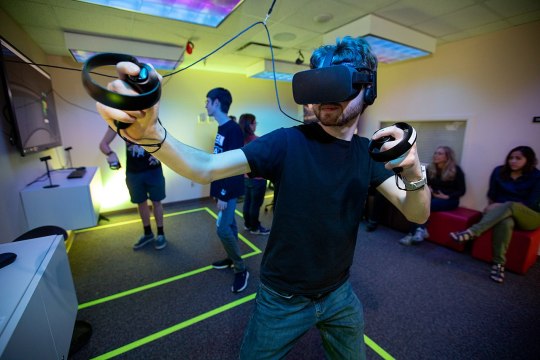
Fig.2: VR gaming set
As technology evolved, VR gaming (fig.2) became more and more accessible and understood by researchers and the wide public. Since 2019 when Oculus Quest took shape and Meta started developing the metaverse, a lot of game studios also started exploring the virtual reality possibilities. In the article “Virtual Reality Gaming Market Size & Share Analysis - Growth Trends & Forecasts (2023 - 2028)”, it is stated that “according to NewGenApps, by 2025, the worldwide user base of AR and VR games is expected to increase to 216 million users” (Virtual reality Gaming Market - trends & companies). This shows a huge increase in the V.R. gaming industry.
As the virtual reality extends, its functionality will be branched in multiple disciplines. I believe in the future, VR will help people like architects and engineers visualise complex projects and from perspectives that would be impossible to reach in real life. However, even with its tremendous potential to ease workflows, these days virtual and augmented reality is mostly used in entertainment “according to 3Dinsider, more than 64% of active VR users believe that gaming has the highest potential to benefit from advances in VR technology.” (Virtual reality Gaming Market - trends & companies). This duality of purpose can also be seen in the film and game industry. The film industry has documentaries and studies, as well as entertainment films. Using the same pattern, the game industry has epistemic as well as entertainment games. As a result, I believe virtual and augmented reality do not have a preferred path, both functions (the entertainment and work) will keep evolving simultaneously as a need for future development.
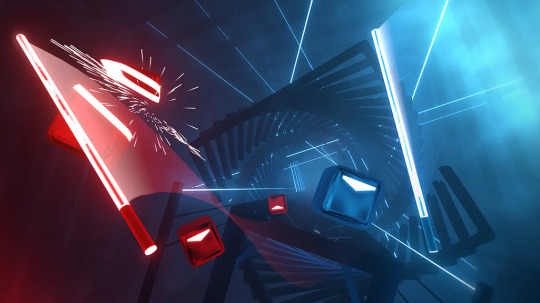
Fig.3: Beat Saber
VR gaming received a lot of diversity when it comes to its game genres in the last few years. Starting with abstract games like Beat Saber (fig.3) which mainly focus on interactivity, up to story based immersive games like exploration, for example Nefertari VR: Journey to Eternity (2018) or horror games, for example Resident Evil Village (2021). These kinds of games allow the player to fully experience dangerous situations in a safe and controlled environment.
youtube
Fig.4 realistic VR games
According to Baudillard(1983:11) there are four phases of the image. First phase contains the images as a reflection or reality (fig.4), which refers to realistic simulations (driving/flying simulations, safari trips etc.). Second phase refers to images that are masking or perverting reality. Imagery like this is used in war and combat games such as Call of Duty, which diminishes the horrors of real life war as entertainment. I believe this kind of imagery to be a very sensitive edge, as it desensitises people and can subconsciously influence children and teenagers to become more violent, if not being supervised and kept under control. Third and fourth phases refer to the imagery that goes beyond reality, a pure simulation. I believe these categories refer to the fantasy, futuristic or abstract worlds that we can’t find in our day to day lives.
Unlike films, in which the viewer needs to be a passive element for the immersive experience, games need the player to be active in order to progress. Researchers such as Marie-Laure Ryan believe that “interaction opposes immersivity and vividness” (Ryan 2003), underlining that in order to have a fully immersive experience guided by emotion, the player needs to be a passive element. However, removing the interactive element from the experience would cancel the fundamental part of a game. In addition, I consider that interaction is part of reality. We constantly interact with different elements in order to progress in our daily lives. As a result, from my perspective, interactivity wouldn't reduce the immersive experience, but with a good balance, it would be beneficial.
To conclude, as technology advances, virtual and augmented reality will slowly start to be more and more part of our daily life. Even though VR mostly grows in the gaming industry, I believe in the future its functionality will spread in different areas being also valued in the working areas. The potential of the new virtual world is limitless and opens the gates to new sensations, experiments and fascinating opportunities.
Bibliography:
Fig.1: Researchgate.net. Available at: https://www.researchgate.net/figure/Sensorama-the-first-virtual-immersion-system-the-technical-table-and-the-pictures-shown_fig1_321142137 (Accessed: January 2, 2024).
Fig.2: Wikipedia contributors (2023h) Virtual reality game, Wikipedia, The Free Encyclopedia. Available at: https://en.wikipedia.org/w/index.php?title=Virtual_reality_game&oldid=1183306571.
Fig.3: Dvorak, M. (2023) Beat Saber launches on PS VR2 today with new Queen Music Pack, PlayStation.Blog. Available at: https://blog.playstation.com/2023/05/24/beat-saber-launches-on-ps-vr2-today-with-new-queen-music-pack/ (Accessed: January 2, 2024).
Fig.4: NerdVid (2018) 10 virtual reality experiences that are too realistic and immersive. Youtube. Available at: https://www.youtube.com/watch?v=9TCHlT3B24w (Accessed: January 2, 2024).
Pcmag.com. Available at: https://www.pcmag.com/picks/the-best-vr-games (Accessed: January 2, 2024).
Virtual reality Gaming Market - trends & companies (no date) Mordorintelligence.com. Available at: https://www.mordorintelligence.com/industry-reports/virtual-reality-in-gaming-market (Accessed: January 2, 2024).
Lutkevich, B. (2023) virtual reality gaming (VR gaming), WhatIs. TechTarget. Available at: https://www.techtarget.com/whatis/definition/virtual-reality-gaming-VR-gaming (Accessed: January 2, 2024).
Monika (2023) Hyperrealistic virtual reality - how far away are we?, Linde. Available at: https://vr.linde.com/2023/01/23/hyperrealistic-virtual-reality-how-far-away-are-we/ (Accessed: January 2, 2024).
Petersen, G. B., Petkakis, G. and Makransky, G. (2022) “A study of how immersion and interactivity drive VR learning,” Computers & education, 179(104429), p. 104429. doi: 10.1016/j.compedu.2021.104429.
0 notes
Text
9.Emotions - Analysing Kratos’ emotional development over God of War game series
In this blog post I will analyse the emotional development of Kratos and his journey starting as a revenge driven slayer, up to the father figure we got to know in the latest games from the series.
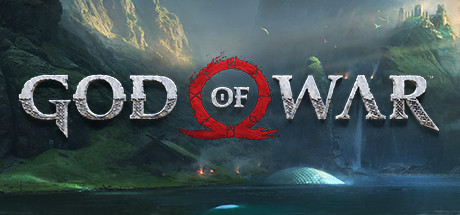
Fig.1 God of War Cover
God of War (fig.1) is an action RPG (role playing game) series, launched by Soni’s Santa Monica Studios in 2005. The first games are based on mythology and present the story of Kratos, a Spartan warrior who was tricked by Ares, the previous Greek god of war, into killing his own family. As a result, Kratos goes on a rampage seeking revenge and killing all the Olympian gods. During this process, Kratos kills Ares and becomes the new god of war. The latest games started in 2018 focus on Norse mythology. After the flood at the end of God of War 3, Kratos is forced to leave Greece and make his way to Midgard. The second part of the franchise starts with Kratos’ second wife Faye passing away, leaving Krathos alone to take care of his son Atreus. Throughout the second part of the series, Kratos and Atreus fight the obstacles of Midgard to spread the Ashes of Faye from the highest peak and stop Ragnarok, the apocalypse of the realm. During the game they discover the bridges between the 9 realms, explaining how Kratos came from Greece to Midgard and leaving an open ending for the future realms.
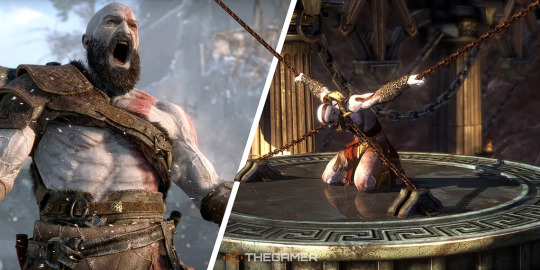
Fig.2 Different stages of Kratos in God of War
Given such a complex series with multiple games, we get to know up close the complex main character, Kratos, and his emotional development over a long period of time. I found his emotional journey very interesting given through how many terrors and sacrifices he had to face. In the first games, Kratos shows no remorse for killing innocent people that get in his way of seeking revenge, for example, the woman he encounters who was enslaved by gods. As we get to understand his story, we realise that most of his violence comes from his no-choice behaviour (fig.2). This means, he believes that his only way to defeat the gods and get his revenge is to become a killing machine, as he has nothing else to lose. As the first games portrait Kratos as a merciless killer, features usually connected with the villain, it is interesting to see why so many people fell in love with the character. The first level on which the player has to connect with the character is the emotional one, in order to fully enjoy an RPG (role playing game). Players understand the grief and injustice and transform it into their own. Another interesting effect that I believe attracted so many players, is the use of violence because of anger and frustration in a constrained and safe environment. The oppressed rage people keep under control in the society, can be released through Kratos.
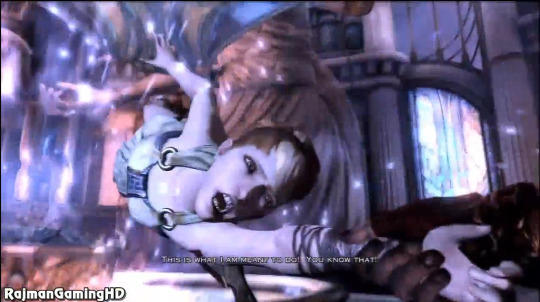
Fig.3 Pandora's death
We can see glimpses of his humanity in the first games when he rescues Pandora, who reminded him of his passed daughter. She is the first character Kratos chooses not to kill. However, when put in the situation to choose between saving Pandora and getting revenge over Zeus, Kratos chooses to fight Zeus and lose Pandora (fig.3). In the first games, he is a character overwhelmed and ruled by emotions, especially anger, whereas in the second part of the series, when he becomes a paternal figure for Athreus, we get to see a totally changed character, a Kratos who hides all his emotions and always tries to stay in control and discipline. One of the main reasons for his emotional change is due to Atreus. Kratos wants to hide his past life from his son, out of shame, as well as fear that Atreus may follow his steps. As a result, from the killing machine driven by anger and revenge, we get to discover a new disciplined Kratos who tries to control and cover his emotional outbursts.
The animators have done an amazing job capturing the emotions of the character, especially in the later games, with the advanced motion capture technology. From body movement, to face expressions, the player can fully understand the emotions of Krathos and emphasise his strong emotions such as pain, anger, fear etc. Previously, animators had a difficult time to manually capture emotions with 3D characters “However, the difficulty is that the viewer of an animations is perceiving emotion through the filter of the animator” (Mobbs 2015;80). I believe that barrier has faded tremendously, as nowadays actors are the ones who give life to the 3D models and technology transfers it into the digital world.

Fig.4 Kratos tree cutting scene
The first key scene which perfectly demonstrates the emotional development is in the beginning of God of War(2018) when Kratos cuts down the marked tree Faye chose to be burned after her death, as their tradition requires (fig.4). Before cutting the tree, Kratos gently hugs the tree and puts his head on the tree trunk, still feeling that connection with Faye. He then starts furiously cutting the tree, until Atreus comes and suddenly Kratos hides his emotions. As the scene develops, Kratos fixes his hand bandages to cover up the scars from his previous weapons, as a symbol of covering his past. Another symbol can be found in his body movement when Atreus moves from one side to another, Kratos moves as well, to hide his arm scars from Atreus, hiding his ugly past from him. Feeling ashamed and trying to cover their actions is a common behaviour of people who have violent outburst episodes. These could be a result of past traumas which is also the case with our character.
youtube
Fig.5 Kratos and Atreus hug
In their article “Playing with Character”, the authors discuss how the character that we get to know is a combination between the avatar (the 3D model) and their emotional traits “constellations of different character traits, combined into a coherent “bundle of differential elements” (Frow, 2014, p. 24) that composes the prattōn's ēthos.” (Vandewalle, A., Malliet, S., & Demoen, K. (2023). ‘Playing with Character: A Framework of Characterization in Video Games.’ Games and Culture). Kratos’ main traits change throughout the game series, which shows his perpetual development “traits are static or dynamic, depending on whether they remain the same throughout the narrative or change as an indication of character development (Eder et al., 2010; Margolin, 1986)” (Vandewalle, A., Malliet, S., & Demoen, K. (2023). ‘Playing with Character: A Framework of Characterization in Video Games.’ Games and Culture). The change from anger and frustration as emotional pillars for his character, to compassion, discipline and fear for his son’s protection, shows the huge emotional journey our main character goes through in the series (fig.5). With the emotional change of the character, the player's emotional bond and perspective also changes. From a way to express anger and become a killing machine, the player now fights to protect the other characters and prevent the apocalypse. It can also be said that from the selfish objective of the first games (revenge over the Olympian gods), Kratos takes a more heroic approach, but not in a stereotypical way. He only accepts to fight in these adventures to protect Atreus and his friends, not as a virtuous character. The players now have an altruist motivation rather than revenge as in first games. The “first-person deepening technique” (Freeman 2004: 4) shows that the way players connect with the character is through responsibility, making choices and sacrificing, all actions with high emotional impact.
In a nutshell, I believe Kratos has one of the most complex character development I have seen so far, illustrating how we are the sum not only of our actions and decisions, but also the sum of our traumas and emotional scars. Beside his fight with the others, through the series, Kratos has an ongoing battle with himself and his emotions. This analysis helped me realise how important it is to add emotional depth to the characters I make, to break them from just an “avatar”. Moreover, it made me be mindful about the emotional traits of my future characters and what effect they would have over the players.
Bibliography:
Fig.1: Steampowered.com. Available at: https://store.steampowered.com/app/1593500/God_of_War/ (Accessed: December 31, 2023).
Fig.2: Quick, W. A. (2021) God of war: Every god and mortal Kratos has killed, TheGamer. Available at: https://www.thegamer.com/god-of-war-every-god-mortal-kratos-killed/ (Accessed: December 31, 2023).
FIg.3: Nocookie.net. Available at: https://static.wikia.nocookie.net/godofwar/images/7/7b/Pandora1.png/revision/latest?cb=20100315085425 (Accessed: December 31, 2023).
Fig.4: Gamingbolt.com. Available at: https://gamingbolt.com/wp-content/uploads/2018/03/40844888651_b2f3fb5b46_o.jpg (Accessed: January 2, 2024).
Fig.5: OCGaming (2022) Kratos Hugs Atreus Scene | GOD OF WAR RAGNAROK cinematic (PS5). Youtube. Available at: https://www.youtube.com/watch?v=-mqyI8Q_7r8 (Accessed: January 2, 2024).
Wikipedia contributors (2023c) Kratos (mythology), Wikipedia, The Free Encyclopedia. Available at: https://en.wikipedia.org/w/index.php?title=Kratos_(mythology)&oldid=1191335117.
FatBrett (2023) Kratos: The incredible transformation of a gaming icon - part one. Youtube. Available at: https://www.youtube.com/watch?v=ZCvsnPFIYaQ (Accessed: January 2, 2024).
FatBrett (2023b) Kratos: The incredible transformation of a gaming icon - part two. Youtube. Available at: https://www.youtube.com/watch?v=hd_KRoMF-5U (Accessed: January 2, 2024).
Freeman, David (2004), ‘Creating Emotion in Games: The Craft and Art of Emotioneering’, ACM Computers in Entertainment, 2: 3, Article 8a, pp. 1–11
Kopp, D. (2022) God of war’s most herculean effort is making Kratos a relatable, humanized father, CBR. Available at: https://www.cbr.com/god-of-war-kratos-character-evolution-playstation/ (Accessed: January 2, 2024).
Reeves, B. (2018) “Review: God of War’s emotional journey elevates Kratos and the series,” Geeks Of Color, 3 May. Available at: https://geeksofcolor.co/2018/05/03/god-war-emotional-kratos-series/ (Accessed: January 2, 2024).
Lindner, N. (2021) God of War: How Kratos got from Greek to Norse mythology in canon, ScreenRant. Available at: https://screenrant.com/god-war-kratos-greek-norse-mythology-canon-change/ (Accessed: January 2, 2024).
1 note
·
View note
Text
8.Politics - Analysing black women as main characters
In this blog post I will discuss some American actresses and their African-American lead character roles in films that impressed and inspired me.
The representation in the media and film industry has not always been as inclusive and diverse as it is today, and even with the progress that society has made these days in promoting cultural diversity, I still believe this is a continuous process that will keep evolving and hopefully improving in the future. It can be argued that nowadays more and more black women are being portrayed in leading roles, and more films and books bring to light emotional and inspiring stories of women of colour.
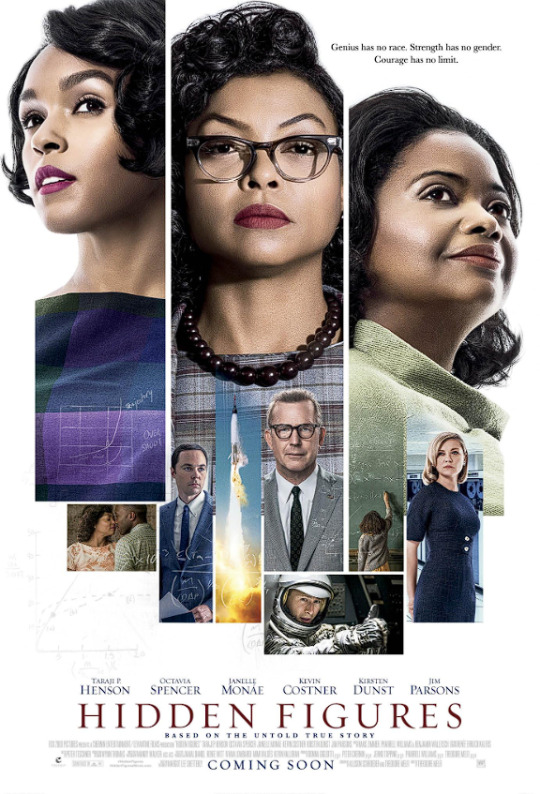
Fig.1 Hidden Figures Cover
One film that perfectly illustrates how women of colour were treated in the 1950s and 1960s is Hidden Figures (fig.1) from the producer Theodore Melfi. The film,based on the book by Margot Lee Shetterly, portraits the lives of three African American women, Katherine Johnson (Taraji P. Henson), Dorothy Vaughan (Octavia Spencer) and Mary Jackson (Janelle Monáe), brilliant mathematicians who worked at NASA and made the launch of John Glenn successful. Throughout the film we get to see the discrimination and colour segregation that was happening during that period, but also how powerful minds such as our main characters, in spite of the injustice, managed to persevere and exceed everyone's expectations and prejudice. The segregation because of race and gender can be seen in the scenes with the toilets and Katherine’s mug “who no one wants to touch” (Hidden Figures,2016). The build up leads to an amazing scene with a strong emotional impact in which Katherine, after being scolded for always disappearing for 40 minutes to go to the bathroom, breaks into tears and confronts the situation. As a result, the next day the leader of the programme breaks the sign of the coloured women’s toilets, symbolising the end of segregation at NASA. The film is made after real events, which is also confirmed on NASA’s website: “While the movie dramatises some aspects, it is true to the struggles of the women at the center of the story. The victories for racial and gender rights were not achieved easily or quickly, and our work is not done. Today, NASA strives to make sure their legacy of inclusion and excellence lives on” (NASA, 2023). All three actresses, Taraji P. Henson, Octavia Spencer and Janelle Monáe, are well known actresses who, just as their characters, persevere and are representative names for their community and keep on inspiring young women all over the world.

Fig.2 How to get away with murder cover
Another amazing actress of colour that really inspired me is Viola Davis. Having leading roles such as Annalise Keating in “How to get away with murder”(2014-2020) (fig.2), Nanisca in “The woman King”(2022), The Help(2011) and many more, Viola is another example of a strong and determined woman. In “How to get away with murder”, she portraits Annalise Keating, a successful lawyer who teaches at one of the best universities. Together with her selected students they resolve different cases, murders and obstacles, showing the good and the bad side of the American legal system. Just like the main characters of “Hidden Figures”, throughout the TV series, Annalise has to fight the discrimination based on her skin colour and gender in the court house, as well as outside of it.
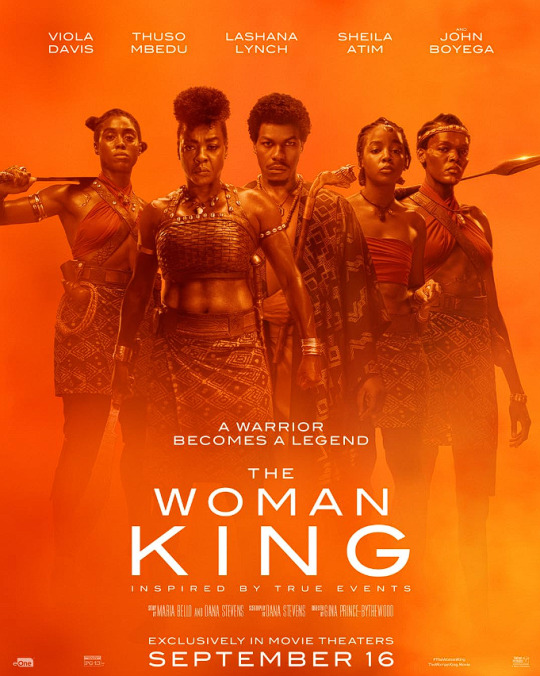
Fig.3 The woman king cover
“The Woman King” (fig.3) is another perfect example of a film that underlines the empowerment of women. In this film, Nanisca (Viola Davis) fights as the head warrior of the Agojie, the all-female unit of warriors who protected the African Kingdom of Dahomey in the 1800s. The producers focused on properly representing the culture without going into stereotypes, as Laura Zornosa states “as a historical advisor, Wantchekon made sure that Dahomey was portrayed as a developed, sovereign state—rather than a stereotypical primitive tribe. The weapons that the Agojie and their male counterparts used, for instance, were often produced locally—certainly not all imported from Europe” (Zornosa, 2022). Nanisca’s character portraits the perfect balance between power, femininity and motherhood, making her a very complex character and a model.
youtube
Fig.4 Tina Brown and Viola Davis Interview 2018
In her amazing interview with Tina Brown in 2018 (fig.4), Viola discusses the gender inequality of pay as an actor, to which she adds that even between the same gender, there is still discrimination based on skin colour. Having an outstanding career: “I got the Oscar, I got the Amy, I got the two Tonys, I’ve done Broadway, I’ve done off Broadway, I’ve done TV, I’ve done film” (Viola Davis, 2018), Viola argues that she is compared with white legendary actors like Meryl Streep “you’re the black Meryl Streep”(Viola Davis, 2018). However, despite this, she says “they had the same path as me and yet I am nowhere near them, not as far as money, not as far as job opportunities”(Viola Davis, 2018), further underlying the discrepancy between them.
In conclusion, even though we have made tremendous progress with having inclusivity and diversity in media, I still believe everything is far from being perfect. Having examples of films, characters and actors, just like the ones I have described above, makes a huge difference for young women of colour from all around the world. I truly believe that showing diversity and inclusivity in media is essential for our society, as it helps people to understand and accept that there are so many cultures and lifestyles different from theirs.
Bibliography:
Fig.1: Melfi, T. (2017) Hidden Figures. United States.
Fig.2: N/A (2014) How to get away with murder. United States.
Fig.3: Prince-Bythewood, G. (2022) The Woman King. United States, South Africa, Ireland.
Fig.4: Women in the World (2018) WITW L.A. Salon: Viola Davis on being told she’s “a black Meryl Streep.” Youtube. Available at: https://www.youtube.com/watch?v=Sf0kDGVkVzQ (Accessed: December 31, 2023).
Biography, R. H. (2023) From hidden to modern figures - NASA. NASA.
Critical analysis of hidden figures: Never give up (2022) Edubirdie. Available at: https://edubirdie.com/examples/critical-analysis-of-hidden-figures-never-give-up/ (Accessed: December 31, 2023).
Master’s Theses (no date) LoLoyola eCommons yola eCommons, Luc.edu. Available at: https://ecommons.luc.edu/cgi/viewcontent.cgi?article=4708&context=luc_theses (Accessed: December 31, 2023).
Zornosa, L. (Originally published: September 16 2022) “The complicated history behind The Woman King,” Time. Available at: https://time.com/6214291/the-woman-king-true-story/ (Accessed: December 3, 2023)
0 notes
Text
7.Representation - Analysing the stereotypes used in The Quarry
This blog post is about how stereotypes are used in “The Quarry” and how it influences the player.
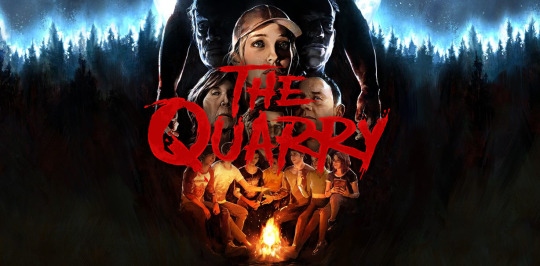
Fig.1 The Quarry Cover
The Quarry (fig.1) is an interactive horror game, released by Supermassive Games in 2022 with positive feedback. The game is directly inspired from Until Dawn, a game also made by Supermassive Games in 2015. However, with “The Quarry”, the studio focused more on the story and with a theme approachable by a larger audience. I chose this game to talk about stereotypes as the main focus of the game is the characters development and how, using the ergodic narrative style of the game, you can influence and connect with the characters.
Switching between all nine teenagers, you need to survive the mysteries of Hackett’s Quarry. While playing with each character, you get to make choices which determine the development of each character. Depending on your choices, characters may discover collectables, die, help other characters survive, and kill the antagonist. Due to so many branches the game can take, the game has 186 possible endings. As the story unfolds you have to survive the werewolf attack and prevent the curse from spreading.
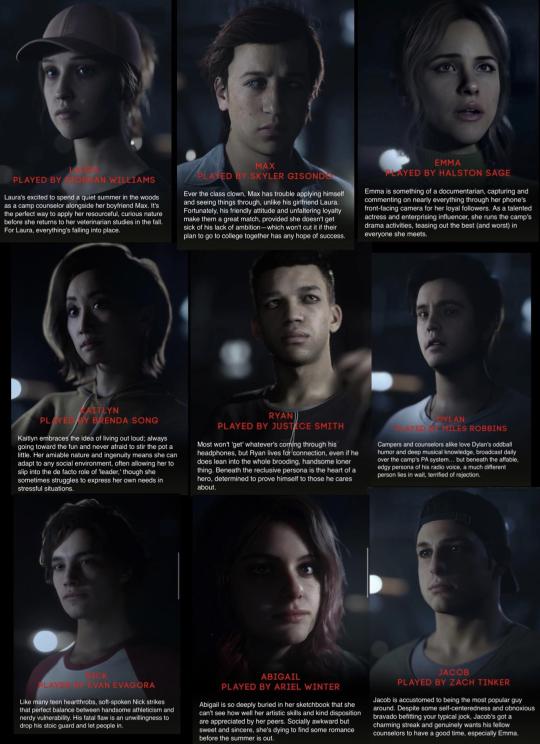
Fig.2 All characters
Each character fits into a stereotypical teenage mould (fig.2): the jock (Jacob), the pretty influencer (Emma), the comic (Dylan), the shy loner (Abigail), the rebellious girl (Kaitlyn), the sarcastic silent (Ryan), the good girl (Laura), the first victim (Nick). Stereotypes are always used in story based games and films, especially in the horror genre, getting influence from films like “Halloween”, “Friday the 13th” and “A Nightmare on Elm Street”, as they are considered the most influential. Researchers believe that “ stereotypes are, in fact, “short cuts” taken unconsciously to help people make decisions more easily and quickly, hence the tendency to unthinkingly accept them.” (Horror movie stereotypes and how they formed the genre (2022) The Eagle’s Eye). Following this statement, I believe that games like “The Quarry”(2022) use stereotypes because it helps the player to connect with the characters faster, having an already preconception about their hypothetical background. This helps the player focus more on the story and care more about the characters.
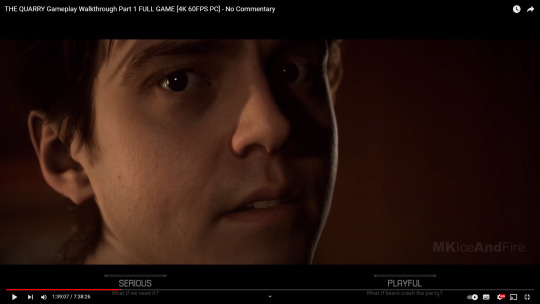
Fig.3 Dylan's Decision
Even though at first sight the stereotypical characters seem shallow, throughout the game, based on your choices, you can see them form more complex personalities. For example, when Dylan and Ryan have to make a choice whether to take the gun from the office or not, the player has to make a choice for Dylan, “the comic one”, to either give a serious answer or a playful one (fig.3). This radical situation shows that the choices the player makes not only affect the narrative outcome, but also the social development of the characters. Of course, the player cannot totally change the structure of the characters, for example the silent shy cannot become the confident jock, as it would break the whole structure of the game and story. As a result, I believe the player can alter the characters, while keeping them in a spectrum, between determined parameters, in order not to affect the role each character has to play in the story.

Fig.4 Werewolf
Stereotypes can also be seen in other elements besides the main characters such as the werewolves, the environment and in some cases, the plot itself. For the werewolves (fig.4), stereotypes are essential, as they help the player recognise the characters, even though it is a mythical creature. If the art department would have totally changed the design of the creatures, the player wouldn't have been able to recognise them. In addition, the narrative uses sometimes stereotypical plot twists specific to the horror genre. I believe the developers decided to use those stereotypes as it is already known to have a good impact on the viewer, creating the tension effects, which is a key factor for the immersive experience.
In conclusion, it is always important to have proper representations that promote diversity and inclusivity, without using stereotypes that are degrading or unrealistic. Even if stereotypes can have a negative impact on society, they have become such a big part of our structure, that in some cases we find them necessary in order to recognize and emphasise with the world.
Bibliography:
Fig.1: The Quarry review (PlayStation 5) (2022) Qualbert | Game reviews that are more than just a number. Qualbert. Available at: https://www.qualbert.com/reviews/the-quarry-review-playstation-5/ (Accessed: December 28, 2023).
Fig.2: Reddit.com. Available at: https://www.reddit.com/media?url=https%3A%2F%2Fi.redd.it%2Fwpmss7tis7o81.jpg (Accessed: December 28, 2023).
Fig.3: MKIceAndFire (2022) THE QUARRY Gameplay walkthrough part 1 FULL GAME [4K 60FPS PC] - no commentary. Youtube. Available at: https://www.youtube.com/watch?v=aoBcpV75TNw (Accessed: December 31, 2023).
Fig.4: Nocookie.net. Available at: https://static.wikia.nocookie.net/thequarrygame/images/f/f5/Werewolf.png/revision/latest?cb=20220616070727 (Accessed: December 28, 2023).
Wikipedia contributors (2023d) The Quarry (video game), Wikipedia, The Free Encyclopedia. Available at: https://en.wikipedia.org/w/index.php?title=The_Quarry_(video_game)&oldid=1191627533.
Toast, G. (2022) The Quarry – Characters –, SAMURAI GAMERS. Available at: https://samurai-gamers.com/the-quarry/characters-18/ (Accessed: December 31, 2023).
Castania, G. (2022) How every character subverts expectations in The Quarry, TheGamer. Available at: https://www.thegamer.com/the-quarry-how-every-character-subverts-expectations/ (Accessed: December 31, 2023).
Effects of stereotypes on personal development (no date) Gouvernement du Québec. Available at: https://www.quebec.ca/en/family-and-support-for-individuals/childhood/child-development/effects-stereotypes-personal-development/definition-stereotypes (Accessed: December 31, 2023).
0 notes
Text
6.Semiotics - Analysing Annie from League of Legends
In this blog post I will discuss the complex character Annie from League of Legends by Riot Games, from a semiotic perspective, using Roland Barthes’ theory (Barthes, 2009).
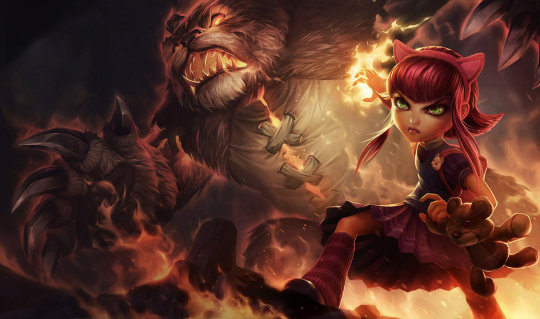
Fig.1 Annie SplashArt
Annie is one of the playable champions from the M.O.B.A (Multiplayer Online Battle Arena) game released by Riot in 2009. I chose her semiotics as I believe she demonstrates the difference between what is seen on the surface and what is the meaning behind. Throughout the evolution of the game, she has received multiple visual updates to match the aesthetics of the game. However, in 2018, Annie (fig.1) also received an update on her lore, so we got to understand more about the character, her background and why she ended up being known as “the Dark Child”. My discussion will be based on the updated lore, and not the previous version.

Fig.2 Annie cinematic wallpaper
Born from parents with an aptitude for magic, Annie inherited the ability of pyromancy from birth. Before she was born, her parents had to move away from the city of Noxus, and rebuild their home near the outskirts, just in time for Annie’s birth. Her biography states that her mother finished sewing the teddy bear Tibbers, a key element of the character, just as she went into labour. After her birth, Annie started to get boiling hot, scaring the mother, who disappeared in the middle of the night, leaving the ill father, the only parent to raise the child. As the story progresses, we find out that the father remarries a Noxus woman who also has a daughter called Daisy. Growing up, the family, especially the new stepmother of Annie, observed the “fiery temper” Annie had, and became afraid and uneasy. Because of an unfortunate event, Daisy dies and the stepmother blames Annie for their loss, making the young girl lose control of her powers and burn the house down, killing her father in the process. In an act of rage and grief, her stepmother tries to reap Tibber apart, which, at the sight of her only memory of her mother being torn apart, makes Annie burst into rage and through a fire storm, Tibbers was brought to life, leaving the girl orphan. The biography ends with her wandering the outskirts of the city, not trusting any adults, but fooling them for clothes and shelter.
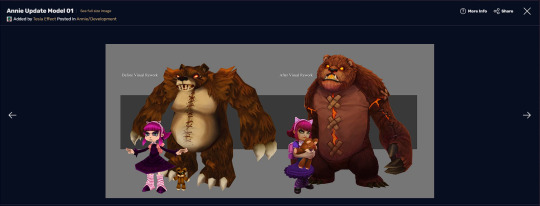
Fig.3 Annie model development
The denotation of the character Annie is quite simple and can be built through the information we get from her biography on the League of Legends website, as well as her cinematic video and splash art. Annie is a young girl with bright red hair and big green eyes, dressed in a pink and purple gothic outfit and wearing a tiara with pointy little horns. She also carries a teddy bear. In the trailer, because of the more realistic art direction, her design has been altered, showing a more innocent child, before she unleashed her dark side. Interestingly, her colour palette has also been slightly modified to look brighter and match the overall colour palette of other Riot games that share the same universe such as Wild Rift.
The connotation side of the character goes much deeper. Her young age and big eyes show the innocent young girl, fragile and delicate. However, when you compare with the dark pink and purple gothic clothes, you can see that her exterior does not match her intentions anymore. The gothic clothes and the horned tiara portrait the rebel, misunderstood child, who chose the dark side because of her traumatic events. In the cinematic, the girl wears a red dress, which better symbolises the fiery temper and the pyromancy powers. Annie’s biography comes to an end with a very interesting phrase that perfectly emphasises her contrast: “On occasion, she will use her disarmingly adorable exterior to be taken in by some pioneer family long enough to be offered new clothes and a hot meal. However, fire and death awaits anyone foolish enough to try parting Annie from the stuffed bear at her side.”
To conclude, following the path of Roland Barthes’ structure of signifier and signified (Barthes 2009), if we add the denotation and connotation of the character, it results the myth of the rebellious orphan child, who chose the path of darkness not because of their latent dark side, but because of the injustice and hate received, which led to trauma. I believe Annie’s character perfectly illustrates the dichotomy between the innocence of a girl child and the dark side of her demonic powers. Annie perfectly matches a flame that can give warmth and nurture, it can also lose control and set everything ablaze.
Bibliography:
Fig.1: Annie, the dark child - league of legends (no date) Leagueoflegends.com. Available at: https://www.leagueoflegends.com/en-pl/champions/annie/ (Accessed: December 28, 2023).
Fig.2: Goslin, A. (2018) Annie gets an animated short to introduce her new lore, The Rift Herald. Available at: https://www.riftherald.com/culture/2018/2/1/16960710/annie-lol-animated-short-new-lore-icons (Accessed: December 28, 2023).
Fig.3: Annie (development) (no date) League of Legends Wiki. Fandom, Inc. Available at: https://leagueoflegends.fandom.com/wiki/Annie/Development?file=Annie_Update_Model_01.jpg (Accessed: January 2, 2024).
Annie (League of Legends) (no date) League of Legends Wiki. Fandom, Inc. Available at: https://leagueoflegends.fandom.com/wiki/Annie/LoL (Accessed: January 2, 2024).
Barthes, R. (2009) Mythologies. London: Vintage.
Annie - champions - universe of league of legends (no date) Leagueoflegends.com. Available at: https://universe.leagueoflegends.com/en_GB/champion/annie/ (Accessed: January 2, 2024).
0 notes
Text
5.Semiotics - Analysing how I use semiotics in my characters
In this blog post I will talk about how semiotics are used in games and how I use semiotics in my own characters in order to give them depth and meaning.
In our daily lives we are constantly bombarded with signs, icons and symbols, which guide us and deliver information faster than text. Just as in our daily lives, in games icons and symbols play a crucial part for the player to understand and interact with the game. From the beginning, the player has to click on the game’s icon to launch the game. Moving forward, the player has to interact with the UI (user interface) to discover the game and access different mechanics and tools such as the menu, the gameplay, inventory, map, etc. The aesthetics of the user interface is important as it must captivate the player, help with the immersive experience, but it should be simple enough in order to easily navigate and not overwhelm the player.
When building my characters, I always try to gather inspiration from mythology, different cultures or even fauna and flora. As I concept art and designing are not two of my strongest areas, I try to find designs in nature or history that already work, and then adapt them to my character. In addition, I want my characters to be complex, to have an interesting background story and lore, as they are a key element for the veracity of the characters. In order to have a good character design, the story of the character has to be shown through the elements of the character, for example deteriorated props, scars, specific features, etc. This is the part where semiotics play an important role in the character’s design, as different props, necklaces, runes, symbols, tattoos, can tell more of the character’s story and personality than what you can see at first glance.
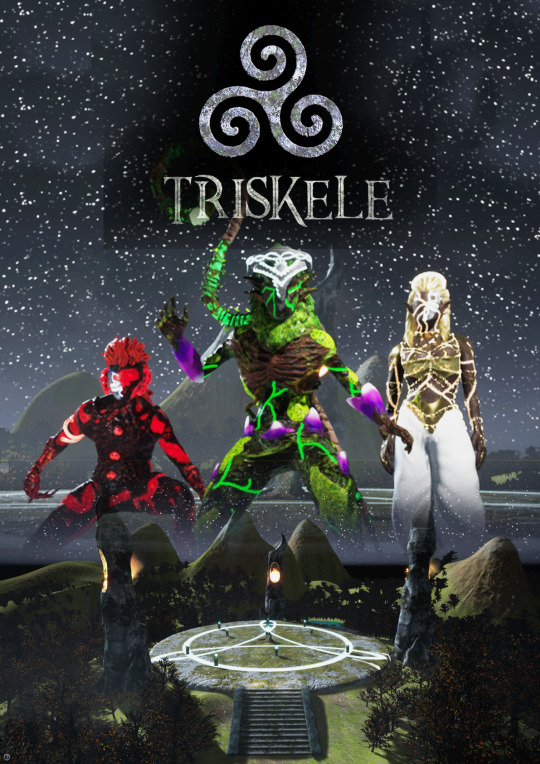
Fig.1 Triskele prototype cover
In one of my recent projects, I designed the characters and a small environment for a game prototype that I created. The game is based on the runes and symbols of the Celtic culture, such as the Triskele and the Triquetra. Triskele symbolises the power of the three in unity. I made the concept of the characters after two of the meanings of the Celtic symbol Triskele: creation-preservation-destruction, spiritual-present-celestial. In the story of the game, a powerful warlock conjures a protection spell to save humanity from extinction when the planet is threatened by an imminent meteor shower. However, the magic required was too much for his body and split his soul into three spirits. You, as the three spirits, find in the old archives a legend of an ancient druid who could help unify your soul and bring back your body.
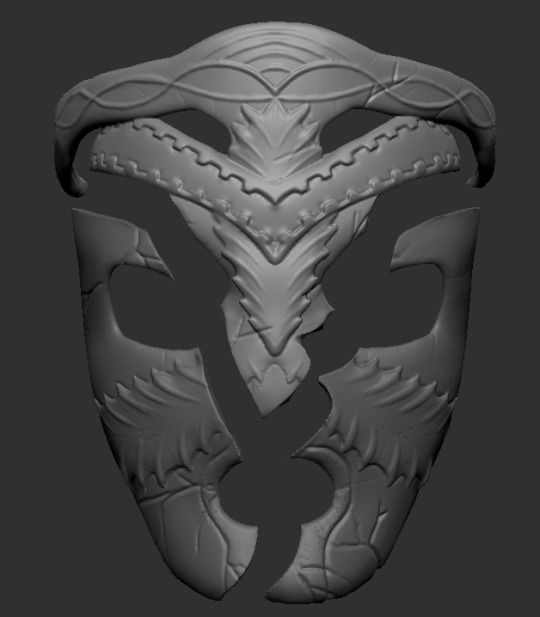
Fig.2 Mask
The three spirits represent creation, preservation and destruction. To unite their designs and connect them to the warlock whose soul got split, I designed a mask that broke into three pieces (fig.2), to symbolise the split soul. Each piece of the mask is placed on the head of the spirit and functions as their face (fig.1). For the mask I also took inspiration from the original Celtic masks as well as “The Green Man” face, which is a symbol of nature and life. The doesn’t have only a denotative function of a face covering, but it also has a connotative meaning, as it is believed that the face (the mask) is a symbol of the soul and that the eyes are the gate to it. In my case I used the symbolic meaning as part of the character’s design.
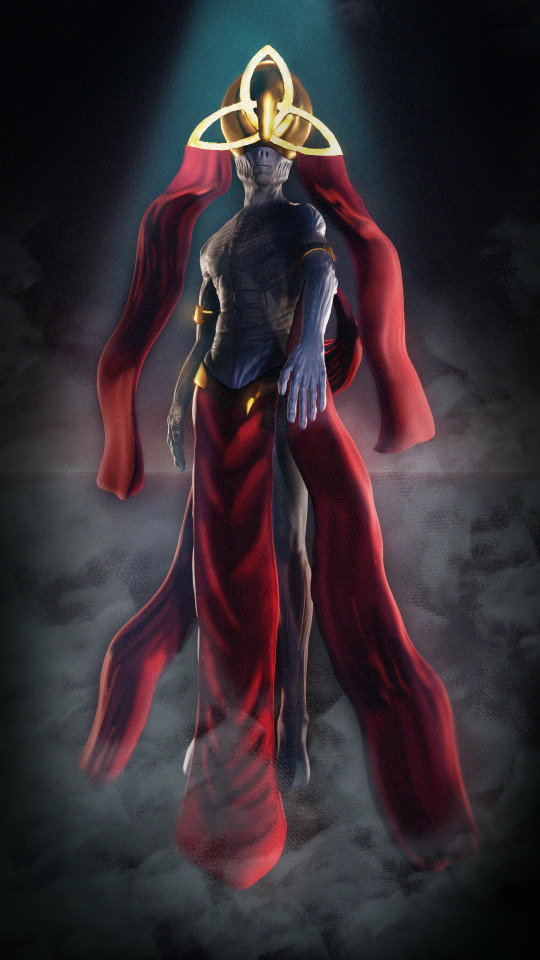
Fig.3 Ancient Druid
In order to keep a cohesive aesthetics throughout the prototype, I implemented the symbols in other elements as well, such as the ritual stone placed in the environment (fig.1), and the head symbol of the Ancient Druid (fig.3). I also thought of the relation between the two symbols: Triskele and Triquetra and used them in the game as the beginning and ending of the game. The split of the souls and the quests of the game are based on the meaning of the Triskele, which refers to the power of three functioning together, but still as separate entities, just like the split spirits of the soul. However, when you get at the end of the game when you meet the Ancient Druid that would unite your soul and bring back the warlock, the symbol is replaced by the Triquetra, which symbolises the power of three unified as a Celtic knot.
To sum up, using semiotics as part of character’s design tremendously helps with the depth and complexity of the character. In my project, the symbols were straight forward, but there are many other characters in games that have more subtle representations such as clothes or features that represent their story and the environment they come from, not just in the fantasy genre. In the future, I intend to keep on working on how I build my characters and what meanings they transmit to the player.
Bibliography:
Fig.1: Artstation.com. Available at: https://theodorobreja.artstation.com/projects/r9B32m (Accessed: December 28, 2023).
Fig.3: Artstation.com. Available at: https://theodorobreja.artstation.com/projects/LeJzK0 (Accessed: December 28, 2023).
0 notes
Text
4.Strategies of Realism - Don’t Scream gameplay reaction by Daz Games analysis
In this blog post I will discuss and analyse the realism of a new horror game demo called ”Don’t Scream”. The demo is being played by Daz Games as one of his gameplay reaction videos.
Daz Games is a youtube channel hosted by Darren (Daz) Blackmore since 2007 when Daz started posting comedy sketches and reaction videos. The channel has a huge success in 2023 reaching 8.44 million subscribers with weekly posts of horror games gameplay, reaction videos (“Daz Watches”), a paranormal investigation series and many more vlogs. I have been following Daz for some years now and I really enjoy his videos. He combines his humour which makes you feel better even when feeling under the weather, with some very interesting and high quality horror games.
I decided to analyse one of his latest horror games because I have always been impressed by its realism. Even if I enjoy horror films, I have never experienced the gaming side of the genre. However, I get to discover and enjoy them through Daz’s videos. I strongly believe that realism is a key factor of a horror game, as the main focus is to make the player scared and immersed in that universe, whether you are in a zombie apocalypse, a haunted house, trying to escape a haunted cave, or in the case of the game that I chose for this blog post, surviving a plane crash.

Fig.1 Don't Scream Cover
The game “Don’t Scream” (fig.1) is a short horror experience released in October 2023 and made by two indie developers Joure and Joe. What brings new is a mechanic that resets the game if you make a sound louder than the medium talking level. In consequence you are not allowed to scream, which is very hard, given all the horrifying jumpscares and the tension the game creates. The game starts after your plane crashes in a forest. Onwards, the main goal is to survive 18 minutes since the game starts without screaming. You are forced to discover new areas of the forest and abandoned places which are filled with spirits, creatures and jumpscares to make you lose the game.
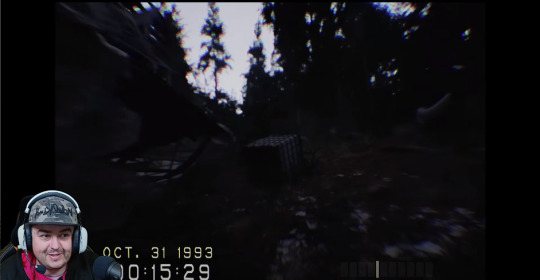
Fig.2 Realistic Environmente
This game perfectly illustrates how realism is used in games in order to create a deep and complex immersive experience for the player. To start with, the game is a simulation, which forces the player (viewer) to engage and actively contribute to the development of the game. To make the experience immersive, the game is constructed as a first person simulation, which means that the gameplay camera is from the person’s point of view (fig.2). This creates immediacy for the player from the start, Daz saying “I don’t think I’ve ever experienced a more tense game” at minute 3:42. As it can be observed throughout the video, especially when Daz enters the abandoned place at min 10:22, he feels uneasy and genuinely scared, breaking the barrier between the video game and reality.

Fig.3 Camera Video Effects
Another factor which adds to the realism of the game is the elements that create hypermediacy (Bolter and Grusin, 1998) such as the date and timer on the left corner of the screen (fig.2). On one hand, this helps the illusion that you see the game through a first person camera, like a documentary, which further allows the presence of the visual effects such as glitches and power cuts (fig.3), that add tension and horror. On the other hand, for some people it can break the idea of an immersive experience, because in reality you would not see everything through a camera. Another element that could break the realism of the game is the lack of body, especially hands, when interacting with objects like opening doors (for example min 5:25) or the ball (min 7:30).

Fig.4 Creature Attack
A fundamental layer of realism that brings everything together is the sensory immersion which stimulates almost all the human senses. This effect is created through the combination of the hyper realistic sounds and graphics. The high quality and amount of detail is amazing, from all the vegetation and foliage of the forest, to all the abandoned and destroyed buildings full of blood, corpses and many more. The game is made in Unreal Engine 5, a game engine released April 2022, well known for its outstanding graphics power. Sound also takes a very important part in creating the eerie atmosphere (as example min 5:42), raising the tension (as example min 26:08) and making the jumpscares effective (as example min 25:25, or 26:40). In addition, all the spirits, creatures and dead bodies that appear are perfectly placed in the Uncanny Valley (Masahiro Mori, 1970) (fig.4). They look familiar enough for the player to recognise, but also altered for the horror effect.
All things considered, the game has a strong sense of realism and believability, which captivates the player and helps them “get lost” in the horrifying immersive experience, effect know as immediacy (Jay David Bolter and Richard Grusin–Remediation 1998). As technology developed, games started to become more and more realistic, nowadays even breaking the immersion barrier with the new VR technology. Maybe in the future the technology will become even more advanced and we will be able to stimulate more of our senses such as tactile and smell, for an even more complex experience.
Bibliography:
Fig.1: Save 15% on DON’T SCREAM on steam (no date) Steampowered.com. Available at: https://store.steampowered.com/app/2497900/DONT_SCREAM/ (Accessed: December 28, 2023).
Fig.2, fig.3, fig4: Games, D. (2023) If you scream the game restarts. Youtube. Available at: https://www.youtube.com/watch?v=h9GkqbwlmtQ (Accessed: December 28, 2023).
Desk, S. K. (2022) Daz games, Sportskeeda.com. Available at: https://wiki.sportskeeda.com/youtube/who-is-daz-games (Accessed: December 28, 2023).
Daz Games (no date) Wikitubia. Fandom, Inc. Available at: https://youtube.fandom.com/wiki/Daz_Games (Accessed: December 28, 2023).
Bolter, J. D. and Grusin, R. A. (1998) Remediation: Understanding New Media. London, England: MIT Press.
Wikipedia contributors (2023d) Unreal Engine, Wikipedia, The Free Encyclopedia. Available at: https://en.wikipedia.org/w/index.php?title=Unreal_Engine&oldid=1192137711.
Unreal Engine (no date) Unreal Engine. Available at: https://www.unrealengine.com/en-US/ (Accessed: December 28, 2023).
0 notes
Text
3.Intertextuality and Transmedia - League of Legends by Riot analysis
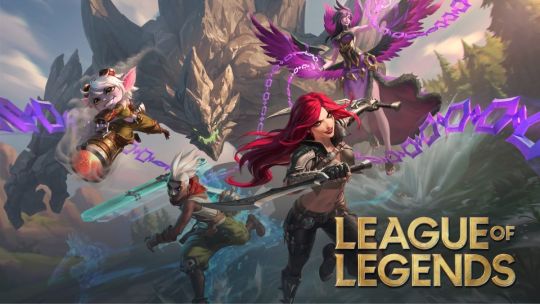
Fig.1 League of Legends Cover
Nowadays, we live in a society where “mass consumption” is a key element. In the last few decades the amount that we consume on any level: food, films, games, entertainment, even work, has increased dramatically, which has led to a higher level of dopamine required for the brain to “feel good”. This led to a constant need of stimulation, which we are not even aware of most of the time. For example: watching streaming platforms while eating and working, playing mobile games while going to work or during breaks.
This constant social consumption motivated companies to extend and create more and more material in order to satisfy the viewers and at least keep them engaged if not bringing other viewers. Gaming studios extended into films, TV series, books, and film studios extended into games, books, comics etc. Another factor of the extension of gaming and streaming companies is the competition between them for “territory” who owns monopoly over the studios and by default, the market. Because studios need to produce so much in such a short time, as the quantity delivered has increased, the quality of it has drastically decreased.
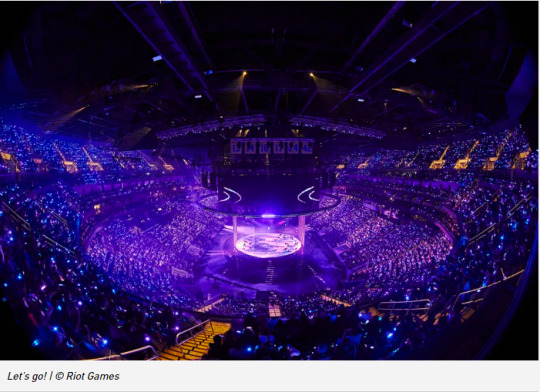
Fig.2 League of Legends World Championship
In the video gaming market many studios tried to extend their franchises, making sequels and prequels of their games, making smaller versions for mobile or even realising small books with the story. However, I believe that the gaming studio that perfectly managed to create a complex transmedia universe is Riot Games through League of Legends (fig.1). Starting from the League of Legends game in 2009 the gaming studio constantly developed adding new playable champions to the game, skins, game modes and events with every update. In 2011 Riot Games started organising League of Legends World Championship (fig.2), with a prize of 100,000$, eight competing teams from Europe, North America and South Asia and 1.6 million viewers. Since then, the championship kept growing with amazing intro shows, live singers, holograms and many more. In 2018 the World Championship final was watched by 99.6million people on streaming platforms breaking the record of its previous year. Through their hard work, in 2019 the game peaked at eight million competitive players and kept growing since then. In present there are 165 unique playable characters for the player to choose from, each having multiple skins, abilities and playstyles. It is impossible for someone not to find at least a few champions to enjoy playing with.
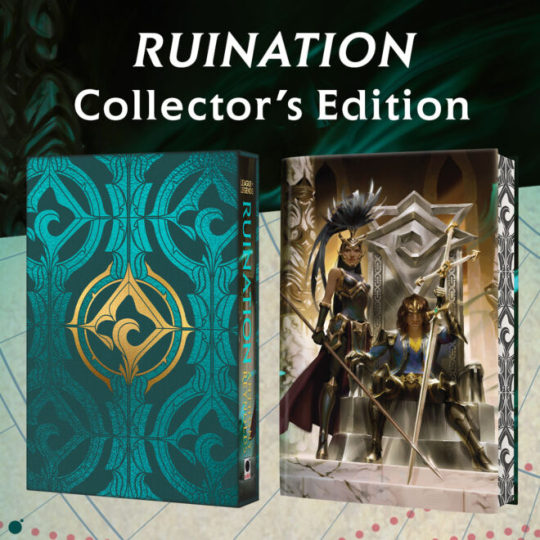
Fig.3 Ruination Book
The champions that are released are not just simple characters. Each of them has a lore and background story that adds a little piece of the puzzle which is the whole Runetera universe, perfectly illustrating Jenkins' multimodality (Jenkins, 2011). Even though the game itself is a MOBA (Multiplayer Online Battle Arena) game, with no actual story play, Riot games put a lot of attention in building the story and complex characters. The world map contains ten distinctive regions: Freljord, Demacia, Noxus, Ionia, Piltover & Zaun, Targon, Shurima, Ixtal, Bilgewater and Shadow Islands. The story is kept alive through the release of cinematics and lore pages during seasons or events. The story expanded so much that Riot released multiple books with background stories of certain champions, art books, world exploration books, and even whole events like ��Ruination: A League of Legends Novel” by Anthony Rynolds. This expansion of the game studio into literature enabled the players to have a better grasp of the reason why certain champions are released and how they connect to each other. It also gives more depth to the game, creating a more immersive experience for the player. It’s not just a 30min game in which you keep fighting random people, it’s a whole world you can explore.

Fig.4 KDA League of Legends K Pop Band
Besides the books and World Championships, League of Legends dived into the music industry as well, adding a new layer of transmedia. Starting with the music released with champion themes and cinematics, in 2014 Riot Games presented the virtual heavy metal band Pentakill in order to promote the release of the skins with the same name. Four years later in 2018 League of Legends got a new virtual band named K/DA (fig.4), a K-pop girl group formed of the in game champions Ahri, Akali, Evelynn and Kai’Sa and interpreted by Cho Mi-yeon, Jeon So-yeon, Madison Beer, Jaira Burns, Bea Miller. The band had a huge success with their singles “Pop Stars” and “The Baddest” which made K/DA the first K-pop girl group in history to achieve this milestone. In the more recent years, Riot has released two more bands True Damage in 2019 and Heartsteel in 2023, formed as well of in-game champions, with huge success. Each champion from the bands got their special skin with the same name as the band. I believe that by creating these fun virtual bands, League of Legends received a new, innovative way of engaging with the players and many more people who are not video-game passionate. The cinematic and music videos have thousands of reviews and reactions from music and film producers from all around the world, granting League of Legends even more publicity.
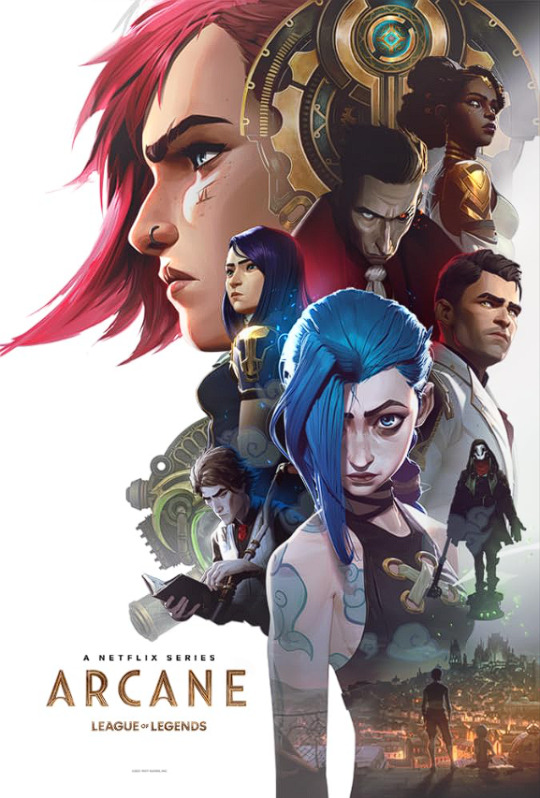
Fig.5 Arcane Wallpaper
Having roots in the gaming, book, comics and music industry wasn’t enough for Riot games and they took a huge step further and released in 2021 the first season of the animated TV series Arcane (fig.5), which had a huge impact among cinephiles. The first season has nine episodes and presents the story between the League of Legends champions Vi and Jinx, and features others like Caitlyn, Jace, Viktor, Ekko, etc. The story reveals a new, more complex side of their lore and adds so much more depth to the universe. Once again, Riot Games used transmedia to bring multiple areas together such as the characters from the game, incorporated in a new cinematic plot and with original music which features legendary artists such as Imagine Dragons and Sting.
In conclusion, I believe that the complex fictional world of League of Legends perfectly illustrates the concept of transmedia: "complex fictional worlds which can sustain multiple interrelated characters and their stories " (Jenkins, 2007). It combines the radical intertextuality, having similar elements across platforms like characters and regions, with Jenkins’ multimodality, having so much variation across many platforms such as virtual bands in music, TV series with extra plots, characters, books, comics with background and side stories. Having such a complex hyperdiegesis hooks the player and attracts even more viewers from other areas, creating a huge fandom. It offers a wide range for the player to interact with and explore, an immersive interactive experience on multiple levels.
Bibliography:
Fig.1: Demirkol, O. (2023) When does LoL split 2 start in 2023: Ranked, gHacks Technology News. Available at: https://www.ghacks.net/2023/07/18/when-does-lol-split-2-start-in-2023-ranked/ (Accessed: December 28, 2023).
Fig.2: Jacobsen, M. (2023) League of legends world championship 2023 cities revealed, RiftFeed. Available at: https://riftfeed.gg/lol-news/league-of-legends-world-championship-2023-cities-revealed (Accessed: December 28, 2023).
Fig.3: Cover launch: RUINATION: A LEAGUE OF LEGENDS NOVEL collector’s edition (2023) Orbit Books. Orbit. Available at: https://www.orbitbooks.net/2023/11/09/cover-launch-ruination-a-league-of-legends-novel-collectors-edition/ (Accessed: December 28, 2023).
Fig.4: Haasch, P. (2020) Meet K/DA, the virtual pop group that teamed up with a fake influencer who made controversial mental health posts, Insider. Available at: https://www.insider.com/kda-members-league-of-legends-riot-games-what-is-twitter-seraphine-2020 (Accessed: December 28, 2023).
Fig.5: N/A (2021) Arcane. United States, France.
Wikipedia contributors (2023) League of legends world championship, Wikipedia, The Free Encyclopedia. Available at: https://en.wikipedia.org/w/index.php?title=League_of_Legends_World_Championship&oldid=1189902922.
Wikipedia contributors (2023a) League of legends, Wikipedia, The Free Encyclopedia. Available at: https://en.wikipedia.org/w/index.php?title=League_of_Legends&oldid=1189383126.
Music - league of legends (no date) Leagueoflegends.com. Available at: https://www.leagueoflegends.com/en-us/news/tags/music/ (Accessed: December 28, 2023).
KDA (no date) K/DA Wiki. Fandom, Inc. Available at: https://kda-lol.fandom.com/wiki/KDA (Accessed: December 28, 2023).
Jenkins, H. (2011) “Transmedia 202: Further Reflections’ Confessions of an Aca-fan". http://henryjenkins.org
Wikipedia contributors (2023a) Arcane (TV series), Wikipedia, The Free Encyclopedia. Available at: https://en.wikipedia.org/w/index.php?title=Arcane_(TV_series)&oldid=1189231328.
Map of Runeterra - universe - League of Legends (no date) Leagueoflegends.com. Available at: https://map.leagueoflegends.com/en_GB/ (Accessed: December 28, 2023).
0 notes
Text
2.Tools - Analysing Diablo IV through the lens of medium specificity and gesamtkunstwerk
Since 1827 when the word “Gesamtkunstwerk” was first used by Karl Friendrich Trahndorff, the idea of the purest work of art that would embody as many art forms as possible has shifted. Starting with the theatre which Richard Wagner considered to be the ideal medium (Wagner, 1849) that combines music, acting, decor, writing, and continuing with the innovation of films, which brought new areas such as editing and visual effects, the evolution of different medias keeps adding more and more, old and new, art districts to create a more complex final result. Nowadays, one of the most flourishing mediums that illustrate the concept of Gesamtkunstwerk is video-games. In addition to the films, the video-game brings a new side of the experience, the direct interaction of the player with what the game has to offer, creating an immersive environment. As Ivan Hewett said in his article “For young classical composers, the peak of ambition is no longer the symphony – it’s the video game” published in The Telegraph: “If Wagner were alive today, he might well be a video game composer.”

Fig.1 Diablo IV Cover
As one of the recent games released in 2023, Diablo IV by Blizzard Entertainment is a perfect example to analyse from Gesamtkunstwerk perspective. The game is an online, open world, third person, RPG (Role Playing Game) set in the hyperrealistic horror genre. Being part of the Diablo series, Diablo IV takes place in Sanctuary (the realm of humans) fifty years after its predecessor Diablo III: Reaper of Souls, and portrays the story of the long rivalry between the angel Inarius and the demon Lilith, father and mother of the Sanctuary. As mentioned above, just from its nature (being a video-game), Diablo IV is a Gesamtkunstwerk, which combines a truly captivating story written by Rafal Praszczalek, outstanding cinematics that occur during the campaign (the main story/quest of the game) made by the development team, incredible soundtrack composed by Ted Reedy & Leo Kaliski that offers a truly immersive experience and a satisfying gameplay.
Millions of people play video-games without appreciating or even being aware of the huge amount of work and time that is invested by an army of artists, programers and technicians, from so many backgrounds, in order to create the game. For Diablo VI only, 9,166 people were credited, which set a new record as MobyGames stated in their Twitter post. Out of those, 2,464 people were involved in the audio, 902 graphic artists, 397 quality assurance team, 394 programmers and engineers and 193 designers (MobyGames, 2023). At the macro level, analysing the amount of people and art districts that are involved in the production is overwhelming, this is why, moving further in the analysis I will only discuss at a smaller scale, the area of character art, an area in which I have specialised in the last few years.
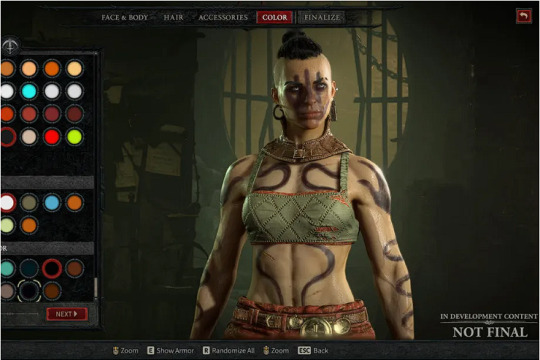
Fig.2 Character Customization
In the game, the element with which the player has to emphasise the most in order for the immersive effect of the Gesamtkunstwerk to take place is the characters and especially the character of the player. To start exploring the world of Sanctuary and the story, the player has to choose from five different classes: Barbarian, Sorcerer, Druid, Rogue, Necromancer. The key part of the experience is the character customization, which helps the player emphasise and transpose themselves into the character (fig.2). The character development is a long process which combines a variety of teams including: 3D modellers, texture artists, fashion artists, props artists, riggers, technicians and voice actors. Only with strong teamwork and collaboration will the final product (the character) be brought to life. To add even more depth to the characters, the writers create lore and background stories that give them complexity and believability.
It is interesting to see the transition of “character art” from paintings and sculptures, to 3D digital models. The process of real life sculpting and 3D sculpting is not that different. Both use tools to sculpt a mass, whether there are physical tools like point chisel, tooth chisel or flat chisel or digital brushes, they all have the same purpose. Similarities can also be found in the process as well. The clay sculpture and the 3D model need to be “baked” in order to get painted/textured afterwards. In my eyes both types of artists have an insane amount of skill in order to create all these realistic sculptures from traditional sculpts like David and Pieta by Michelangelo to all the digital creatures and characters that appear in our favourite films and games. Nowadays we got so used to seeing all these fantasy worlds and creatures that I believe it desensitised our perception of them. Now entire films like Avatar (2009) are based on fully digitalised worlds with SF creatures and still people can emphasise with them and immerse themselves in those totally digitised universes.
However, we cannot deny the medium-specific elements (Greenberg, 1940) and differences that appear between the traditional and digital sculpting of characters. It could be argued that digital sculptors have an “easier life” regarding sculpting, due to the infinite material, all the different software functions such as “undo” when u make a mistake or the symmetry which can save dozens of hours of work. In addition, the digital sculptors can enjoy the comfort of their room or desk setup while working. However, the traditional sculptors may find the idea of not being to touch the model and feel the materials be uninspiring and cutting some of that creative “madness” and connection between the artist and the artwork.

Fig.3 Horseman Fig.4 Jamir Blanco art
As a character artist myself, I always try to get inspiration from both areas. There are some extraordinary digital sculptors like Marco Plouffe (fig.3) and Jamir Blanco (fig.4) who create hyperrealistic sculptures and who inspired me to follow this path. Even so, I believe that in order to get to that level where you use technology as a tool to manifest your creative ideas and not the other way around, you need to have a deep knowledge of the basics in order to have a strong base to work on and add all the “eye catching special effects”. This is where the traditional sculptors have exceeded because they do not have the tricks to hide any mistakes or uncertainties. Thus, when I research anatomy, proportions and different stances, I always try to find references from traditional sculptors.
To conclude, there is a huge amount of work, time and resources put together by an army of artists in order to bring to life the games that we play. Hundreds of art departments from different areas collaborate in order to have the best result possible, which I believe to be the essence of Gesamtkunstwerk: “total work of art” (Trahndorffin, 1827). Despite the evolution of the digital world and the transition from traditional to digital sculpting, each area has its own elements of medium-specificity, advantages and disadvantages that inspire artists no matter their area of practice and bring joy to the viewer or player.
Bibliography:
Fig.1: Sinclair, B. (2022) Diablo 4 devs describe mismanagement, crunch, GamesIndustry.biz. Available at: https://www.gamesindustry.biz/diablo-4-devs-describe-mismanagement-crunch (Accessed: December 27, 2023).
Fig.2: McWhertor, M. (2022) Diablo 4’s character creator does just enough, Polygon. Available at: https://www.polygon.com/23498216/diablo-4-character-creator-impressions-blizzard (Accessed: December 27, 2023).
Fig.3: Artstation.com. Available at: https://marcologue.artstation.com/projects/Gevee1 (Accessed: December 27, 2023).
Fig.4: Artstation.com. Available at: https://www.artstation.com/artwork/Alkz5N (Accessed: December 27, 2023).
Hewett, I. (2022) “For young classical composers, the peak of ambition is no longer the symphony – it’s the video game,” Sunday telegraph, 17 July. Available at: https://www.telegraph.co.uk/music/what-to-listen-to/young-classical-composers-peak-ambition-no-longer-symphony/ (Accessed: December 27, 2023).
Wagner, R. (1849) Das kunstwerk Der zukunft.
Greenberg, C. (no date) Towards a Newer Laocoön, Tfreeman.net. Available at: https://tfreeman.net/resources/Phil-330/Greenberg.pdf (Accessed: January 4, 2024).
Suleman, F. (2023) Over 9,000 people came together to make Diablo 4, exputer.com. eXputer. Available at: https://exputer.com/news/games/diablo-4-credits-community/ (Accessed: December 27, 2023).
Wagner, R. (no date) Gesamtkunstwerk, The Art Story. Available at: https://www.theartstory.org/definition/gesamtkunstwerk/ (Accessed: December 27, 2023).
Lev manovich (no date) Manovich.net. Available at: http://manovich.net/index.php/projects/post-media-aesthetics (Accessed: December 27, 2023).
Wikipedia contributors (2023a) Diablo IV, Wikipedia, The Free Encyclopedia. Available at: https://en.wikipedia.org/w/index.php?title=Diablo_IV&oldid=1189890981.
Northup, T. (2023) Diablo 4 review, IGN. Available at: https://www.ign.com/articles/diablo-4-review (Accessed: December 27, 2023).
0 notes
Text
1. Narratives - Analysing the narrative structure of Until Dawn
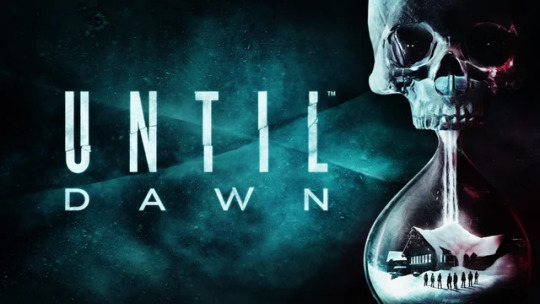
Fig. 1 Until Dawn Cover
Until Dawn is an interactive horror video game developed by Supermassive Games and published by Sony Computer Entertainment. The story takes place at a lodge on Blackwood Mountain, where eight teenagers reunite, despite the tragedy that happened a year before when one of the character’s twin sisters ran to the forest and fell off a cliff edge, as a result of a cruel prank. The bodies of the girls were not found and the sisters were declared missing. Throughout the game, the characters discover the mysteries of the lodge, the abandoned asylum and the mine caves, while being terrorised by a masked man who was looking for revenge and the wendigos that were hiding in the caves.

Fig. 2 Butterfly Effect Interface
One of the strongest points of this game is its narrative. Written by Larry Fessenden and Graham Reznick, the story is captivating, with multiple plot twists which makes it unpredictable. The narrative development of the game really intrigued me, as it is using a decision making butterfly effect system (fig. 2) which perfectly illustrates Aarseth’s “ergodic” narrative (Aarseth, 1997). In order to progress in the story, the player has to go through a combination of cutscenes and third-person exploration, which contain multiple decision making instances. The system is even more complex, as the player gets to control the actions of each of the characters, one at a time, switching between them as the story develops. The decisions directly affect the development of the story, as the characters may die or influence the outcome of the other characters, leading to different endings.
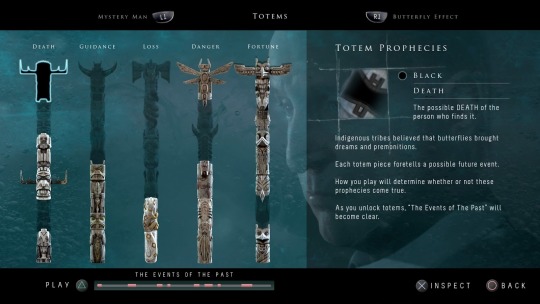
Fig. 3 Totem Game Mechanics
While analysing the narrative using Aarseth’s structure, I realised that even if at first the game shows a clear “tree” structure (Ryan, 2003), where at each decision point, depending on which action you choose, the story will develop on that branch, the game may also have sort of a “network” structure (Ryan, 2003). In the game there is a game mechanic which allows the player to collect hidden totems around the map (fig. 3). Each totem shows a fragment of the possible outcome of a specific decision point, which may help the player with their decision. In addition, because the game is played through multiple perspectives of different characters, the player may get to the same outcome of the story through different branches of the story, making them neither completely free nor limited to a single course. Because of its complex tree structure, the game shows a really excellent balance between the embedded narratives, which already exist prior to the choice making, and the emergent narratives which appear due to the decision making and the interaction with the other characters and environment.
Another layer of the narrative that I found interesting was the blending between the traditional and experimental type of narrative, used to add a new level of complexity to the story. Looking on a macro perspective over the development of the story, the narrative follows the traditional narrative arcs (Todorov, 1939 - 2017), has a clear narrative closure (in the end the games shows who survived, who did not and what is the police verdict), and psychologically rounded, complex characters, who you get to emphasise with as the story develops. As previously mentioned, the story follows the traditional story arcs, also known as the pillars or Freytag’s pyramid, which Gustav Freytag introduced the concept in his book “Technique of the Drama” (1863). In the exposition, the time and place are set and the characters are introduced, as well as any necessary background story that would help the viewer/player contextualise the story (the lodge on Blackwood Mountain, the eight teenagers, the background story of the lost twin sisters and the reason they reunited). The rising action is the part in which “the plot thickens”, when the characters have to overcome critical situations, discover the environment and develop (in the game, the characters split to uncover the mystery and each of them is terrorised by the masked man and the windigos). The third part is the climax, which contains the culmination point when the tension reaches its peak (the characters get to confront the masked man and counterattack). Following is the falling action part or the final suspense, in which the viewer/player is given “the plot twist” and the ending becomes uncertain (the characters find out the identity of the masked man). The final part of the story is the resolution which brings the story to its closure and shows the either good or tragic ending. (the police arrive and declare the dead, survivors and if the criminal is captured or not).

Fig. 4 Dr. Hill Room Beginning Fig. 5 Dr. Hill Room Deteriorated
Looking at a micro level over the development of the story, the narrative becomes more complex and not as linear as it seems at first glance, bringing some elements of the experimental narrative such as disruption of dramatic units and non-linear causation. The disruption of the dramatic units starts when Dr. Hill is introduced. At first Dr. Hill is presented as your psychologist, outside of the story, with little to no context, who gives you short psychological tests. Depending on your choices, the game will use your chosen fears to scare you during the game. As the game develops, the game is paused and you are transported to Dr. Hill’s room for more tests, each time the room becoming more deteriorated and strange, to resemble the character’s mental health (fig. 4 and fig. 5). In the final meeting, after we discover the identity of the masked man, we realise that Dr. Hill and the room is just a hallucination of the main character Josh (who turns out to also be the killer). The non-linear causation is given by the constant switching between the perspectives of the eight teenagers. The game most of the time alternates between parallel events, letting the game develop up to a certain point before going back and switching the perspective to another character. However, sometimes the game develops more on certain characters and later in the story the perspective of another character fills up the plot holes that appear during the story development.
To sum up, Larry Fesseden and Graham Reznick, with the help of the development team, managed to create a story based game with a complex narrative structure. Until dawn manages to balance so many layers of story development and mechanics, which gives the player a hyper realistic simulation where they are immersed in a beautiful and horrifying story.
Bibliography:
Fig. 1: Until Dawn guide (no date) IGN. Available at: https://www.ign.com/wikis/until-dawn/ (Accessed: December 27, 2023).
Fig. 2: Butterfly Effect (no date) Until Dawn Wiki. Fandom, Inc. Available at: https://until-dawn.fandom.com/wiki/Butterfly_Effect (Accessed: December 27, 2023).
Fig. 3: My first thoughts (no date) EllexMay. Available at: https://www.xgardenofedenx.co.uk/2017/07/my-first-thoughts-until-dawn.html (Accessed: December 27, 2023).
Fig. 4: Megabearsfan.net. Available at: http://www.megabearsfan.net/image.axd/2015/9/UntilDawn-trophy_psycho_path.jpg (Accessed: December 27, 2023).
Fig. 5: Softpedia.com. Available at: https://news.softpedia.com/news/until-dawn-diary-dr-hill-is-a-burden-to-the-game-491360.shtml#sgal_0 (Accessed: December 27, 2023).
Ryan, Marie Laure, (2003). Narrative as Virtual Reality. The
John Hopkins University Press.
Aarseth, E. J. (1997) Cybertext. Baltimore: The Johns Hopkins University Press.
Masterclass.com. Available at: https://www.masterclass.com/articles/five-act-structure (Accessed: December 27, 2023).
Wikipedia contributors (2023) Until Dawn, Wikipedia, The Free Encyclopedia. Available at: https://en.wikipedia.org/w/index.php?title=Until_Dawn&oldid=1190059790.
Dr. Hill (no date) Until Dawn Wiki. Fandom, Inc. Available at: https://until-dawn.fandom.com/wiki/Dr._Hill (Accessed: December 27, 2023).
0 notes
Text
Reader
Aleena Chia (2022) ‘The metaverse, but not the way you think: game engines and automation beyond game development’, Critical Studies in Media Communication, 39:3, 191-200, DOI: 10.1080/15295036.2022.2080850
In this article Aleena Chia analises the automaticity of game engines as tools and how they affect the production of games, as well as the people who produce them. The author points out different aspects of the technology development in games and more, such as the automatisation of game engines being used to ease the workload of artists and not to replace them, or how on one hand they allow the game developers to have more freedom and creativity to build their game universe, but on the other hand how it constrains and locks the developers in certain systems. This article perfectly reflects the medium specificity of the digital area regarding gaming, as well as beyond (“meta”). As a person who follows the updates released by game engines such as Unreal Engine and Unity, and the introduction of A.I. in the workflow, I am excited but also worried of how the artistic side of the digital media, including video games, will evolve.
Blom, J. (2023) ‘Video Game Characters and Transmedia Storytelling: The Dynamic Game Character’. Amsterdam University Press.
In this book, Blom discusses the importance of characters and how they stand as pillars for transmedia objects. For his analysis he focuses on three elements: transmedia storytelling, Japanese studies and game studies. Throughout the book, Blom treats characters as individual study subjects, not as just part of the narratives, explaining how characters have different transtextual identities. In one of the chapters, he also discusses strategies on how to control a character’s transtextual identities. He refers to these types of characters as “dynamic game characters”. In the final chapters of the book, Blom discusses the future of dynamic characters as a part of the affect economics in digital media, underlining how they enhance personal experiences. As an artist specialised in characters, I found it very useful to see a different perspective of characters, not from narratives perspective. It also helped me have a better understanding on how to build my characters in a way that they would be coherent through transmedia.
Devine, T. C., Presnell, W. A., & Miller, S. (2014). ‘Games as Art and Kant’s Moral Dilemma: What Can Ethical Theory Reveal About the Role of the Game Designer as Artist?’ Games and Culture, 9(4), 277-310. https://doi.org/10.1177/1555412014538812
This article discusses the importance of ethics in video games and the responsibility artists and designers have. With a variety of research, images and diagrams, the authors use Kant’s ethical theory to explain concepts such as “categorical imperative”, “maxims”, “duties”, “kingdom of ends” etc. Moving forward into the article, the authors analyse the game Fallout 3 by Bethesda Game Studios through the eyes of Immanuel Kant and how he would react in the choice-making situations the player is put in during the game, applying the theories they previously explained. I have always enjoyed learning about philosophy, so learning about Kant’s ethics theory and seeing it applied to games ethics, was intriguing. It helped me realise the responsibility I have as a game designer and how my decisions, like character design, narratives and mechanics (story progression based on decision making) can have an impact over the players.
Fizek, S. (2022) ‘Playing at a Distance: Borderlands of Video Game Aesthetic.’ 1st edn. Cambridge: The MIT Press.
This book presents the variety in which players can play and interact with games and how, by their diverse constructs, games can influence us. Throughout the chapters in which she analyses the different types of play, Fizek introduces a new approach by adding the concept of distance, which means the player’s immediate action is now computerised. In the postlude, the author states “I was fascinated not only by how we play with computers, but also how they play with us”, which I believe to be the essence of the book. I found this book intriguing as it showed me a different approach from the classical view of ludic player-game interaction. In a society in which technology evolves at an extreme speed and the video game industry plays a bigger and bigger role, I believe it is essential for game developers and artists to understand how the digitalised medium interferes with the fundamentals of play.
Harrer, S. (2018;2019;) ‘Games and Bereavement : How Video Games Represent Attachment, Loss and Grief.’ 1st edn. Bielefeld, Germany: transcript Verlag.
This book analyses how bereavement and grief are being represented in video games. Starting by explaining the theory of ergodic narratives and game interactivity, in the first chapter, Harrer discusses the “myths” such as “ergodicity myth” and “Interactivity myth” to explain how they influence the affect and emotional involvement of the player. Further, she talks about bereavement and grief using Freud’s theory and Kübler-Ross five stages of grief, which is the most famous bereavement model in Western culture. In the second part of the book, the author uses the previous theory to discuss how different types of loss are being represented in games. Harrer also discusses ways of using game designs as art therapy for grief. I found this book intriguing as it analyses a very sensitive subject, which ironically has been desensitised in today’s games and media. Because I have an affinity for dark fantasy, this book helped me consider how I should interpret and depict death, grief and bereavement in a realistic and respectful way.
Maureen Thomas (2009) ‘Taking a chance on losing yourself in the game’, Digital Creativity, 20:4, 253-275, DOI: 10.1080/14626260903290265
In the third chapter of this article entitled “playing the hero”, Maureen talks about the female representation as main characters in games, taking the character Lara Croft from Tom Rider as model. This article analyses how Lara Croft is more than just a female character, she is a “female avatar in a men’s shaping”, as Maureen states. The author argues how in order for the woman to be the heroic main character, she has to be aligned to the norm predefined by men and go through many previously considered manly challenges, while also being a symbol of femininity, with sensual moves and exaggerated female body. This source helped me see a different perspective on female representation in games, that even the most famous female characters who want to be seen as feminist and empowering women, are still moulded through the masculine stereotypes and the male gaze. It also made me question my own concepts and use of feminine characters, as a character designer, and how subconsciously may be influenced by the already existing structures and stereotypes.
Sang Jin Kim, Kyung Hoon Kim & Pekka Mattila (2012) ‘The Role of Fashion in the Characters of Online Games’, Journal of Global Fashion Marketing, 3:2, 81-88, DOI: 10.1080/20932685.2012.10593110
This article presents the importance of fashion as a visual stimulus and proposes a conceptual model that evaluates the relation between character fashion, storytelling and game satisfaction in Massive Multiplayer Online Role Playing Games (MMORPG). With strong research and evidence, the authors argue that character fashion plays a key role in the immersion and satisfaction of the player. They also state that people being able to find themselves in the character also increases the level of their satisfaction towards the game, as it can be demonstrated through all the items purchased with real money in order to create unique and fashionable characters. I found this research very interesting and useful as it is strongly connected with my area of practice. Clothes play a big part in the design of the character, as it gives personality and uniqueness. This article helped me understand the importance of characters' clothing and how it influences the relationship between the game and the player.
Shaffer, D.W. (2008;2007;2006;) ‘How computer games help children learn’. 1st edn. Basingstoke;New York;: Palgrave Macmillan
This book discusses how games can be used as teaching tools. The author begins by describing what makes an activity a game and how not games are “fun” or win-lose situations. Shaffer uses epistemic games made by researchers to exemplify how they can be used for a wide range of teaching. Each chapter talks about a game project: “The Debating Game”, to teach epistemology, “Digital Zoo” for physics and engineering knowledge, “The Pandora Project” which teaches values through medical procedures and biology, “Science.net” that teaches journalism and “Urban Science” which revolves around building cities. I strongly believe this book is very useful, even if it’s from 2008, as it perfectly demonstrates the epistemic side of the gaming industry, and in present days we get to see more and more games like these. This book made me think about how I can incorporate educational elements in my games and characters to add a more complex dimension to them.
Summers, T. (2016) ‘Understanding video game music’. Cambridge: Cambridge University Press.
In this book, Summers discusses how music and games have intertwined elements and are more similar than we think. In the first part, he focuses on describing the musical components of games and their functionality, while the second part focuses on the roles and effects of music in games. The author starts with an analogy of the word “play” that is used for both musical instruments and games, which I thought to be very interesting. Throughout the book, Summers explains how music is also used in games to identify characters' nationalities or underline their theme, as well as how music can actually stimulate players' performance in action games. As music and sounds play a crucial part in the immersive experience of the games, I found this book ideal for someone who wants to understand how music influences the gaming experience.
Vandewalle, A., Malliet, S., & Demoen, K. (2023). ‘Playing with Character: A Framework of Characterization in Video Games.’ Games and Culture, 0(0). https://doi.org/10.1177/15554120231179496
This article focuses on analysing the understanding of the ways through which games present character traits. Throughout the discussion, the authors explain the relation between the components that do the characterization: developers, voice actors, and the players through the character customization, exemplifying using Aarseth’s 1997 ergodic characterisation. They also talk about different aspects of how the narratives and characters are directly influenced by each other, analysing and explaining the character construct elements through the story world cues, as well as the medium cues. As a character artist I found it fascinating to see how every small detail from actions, voice, environment etc, can build up the story and complexity of the character, directly and indirectly. This article helped me think of new ways to add detail and background on my own characters in order to make them more rounded and with depth.
0 notes